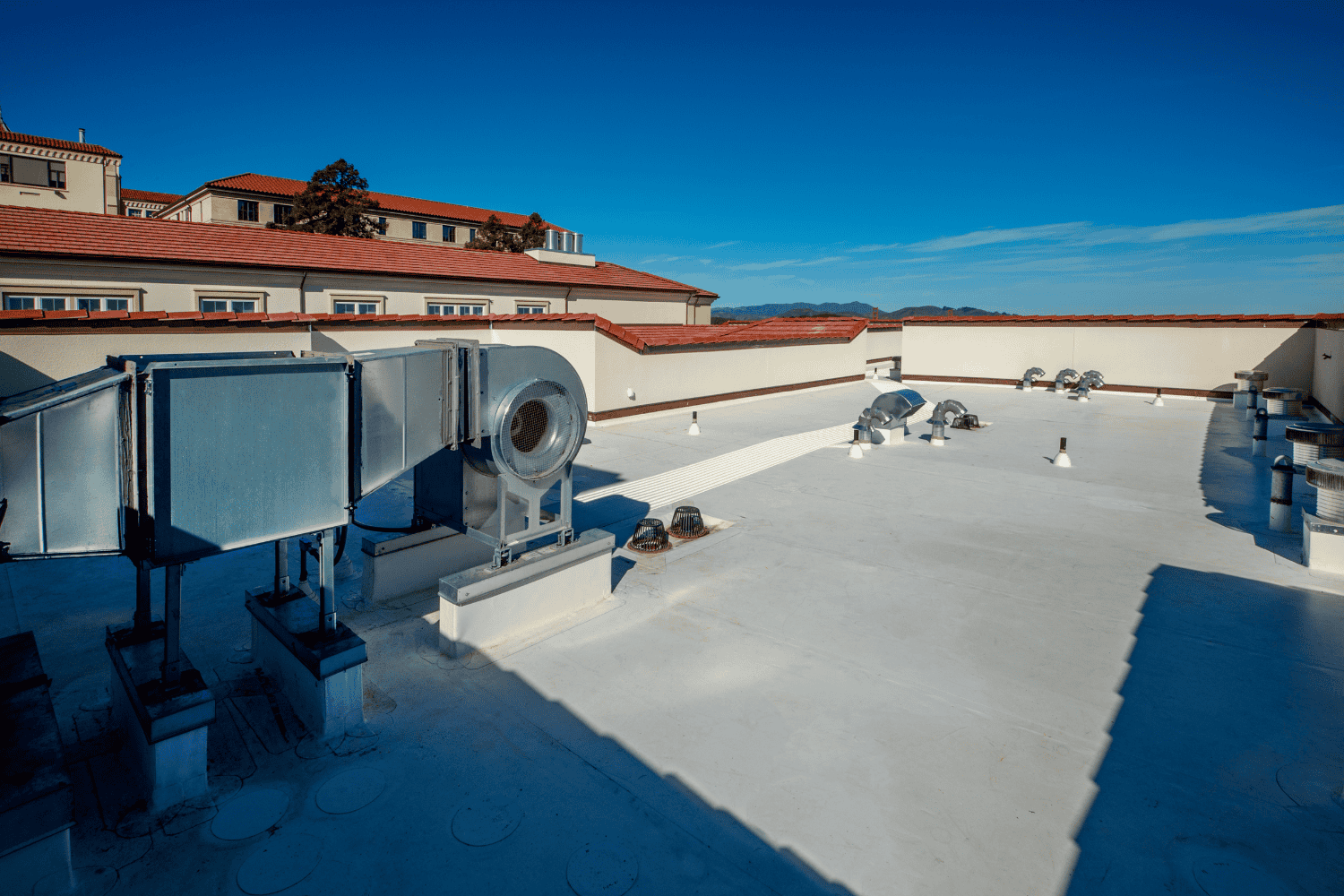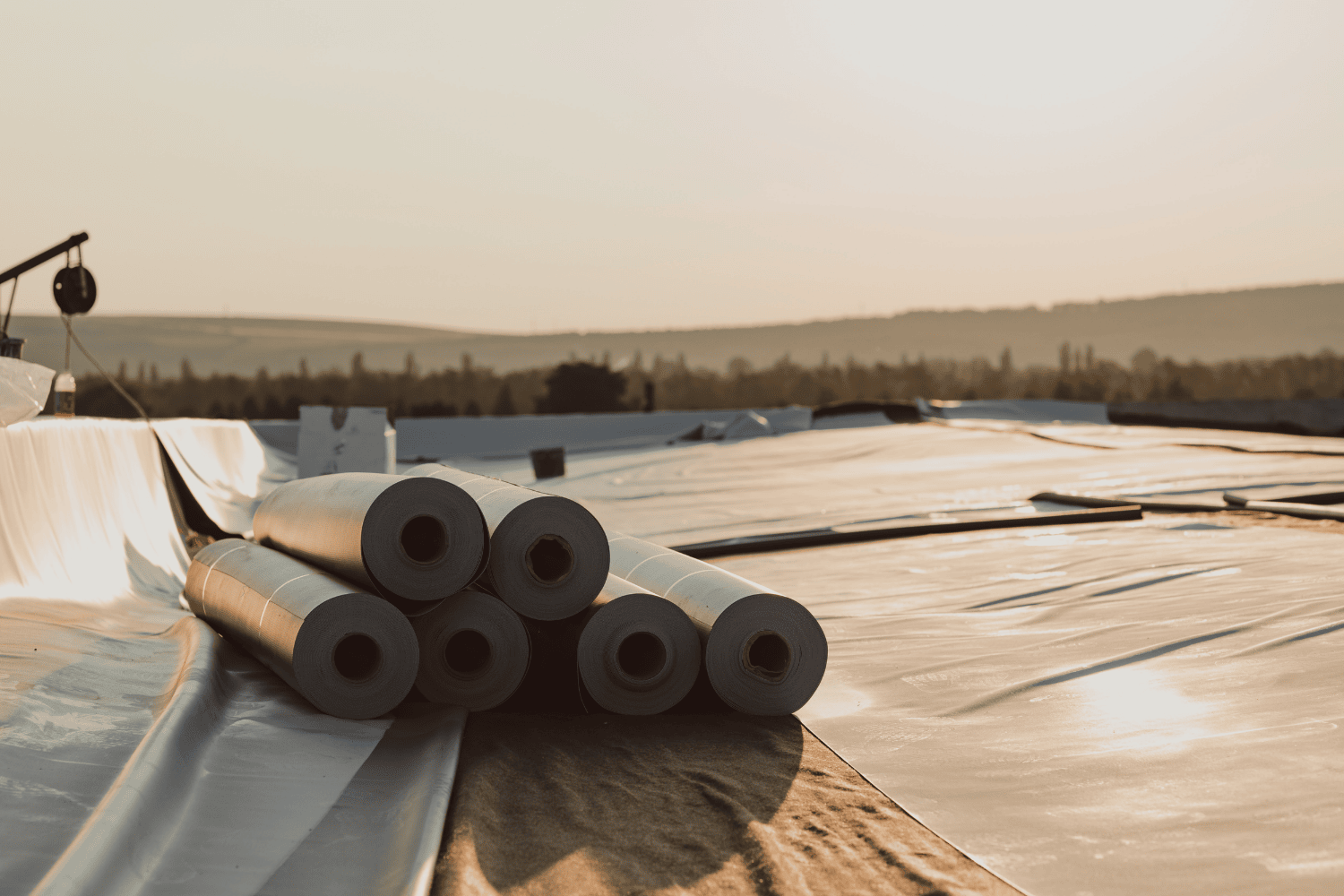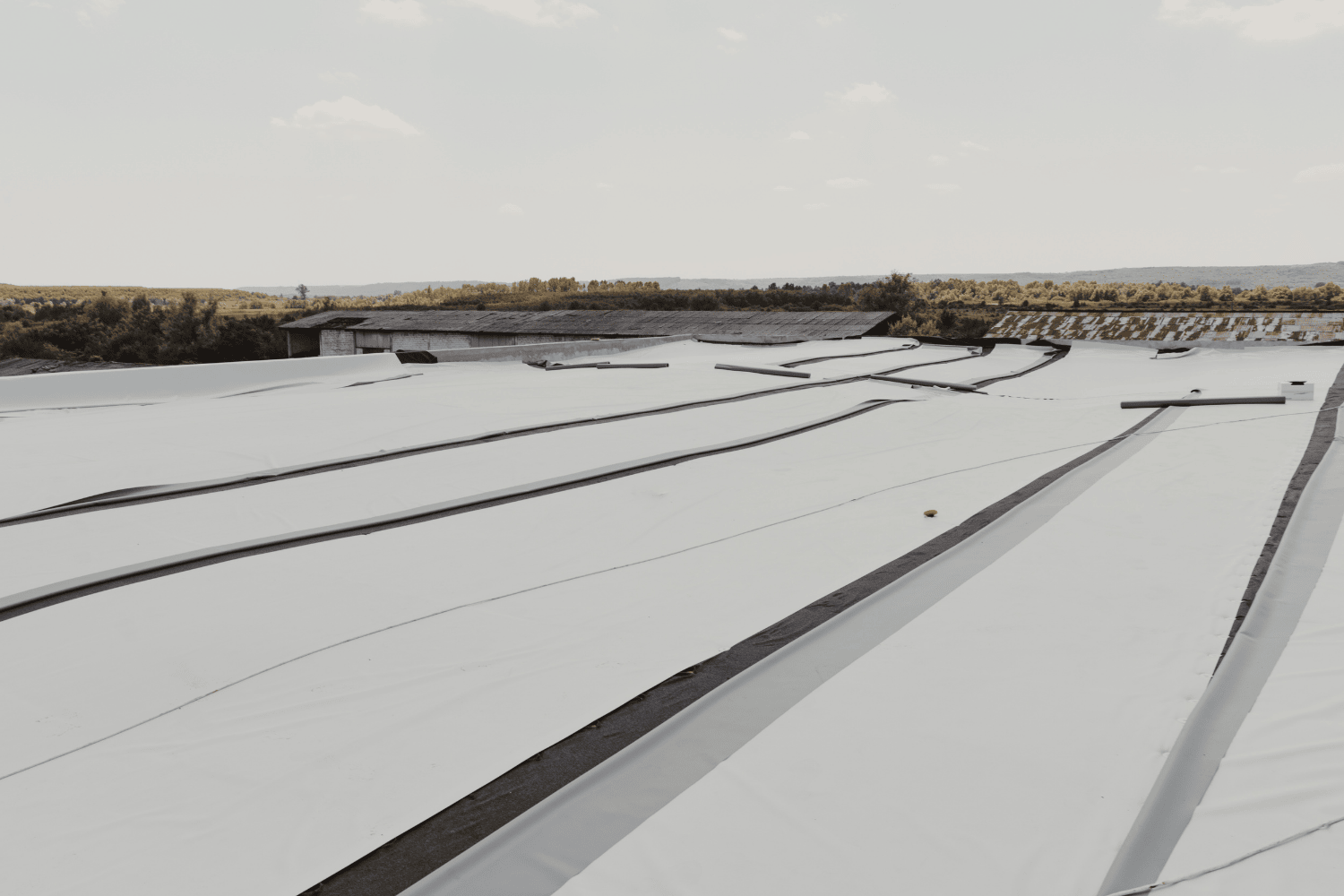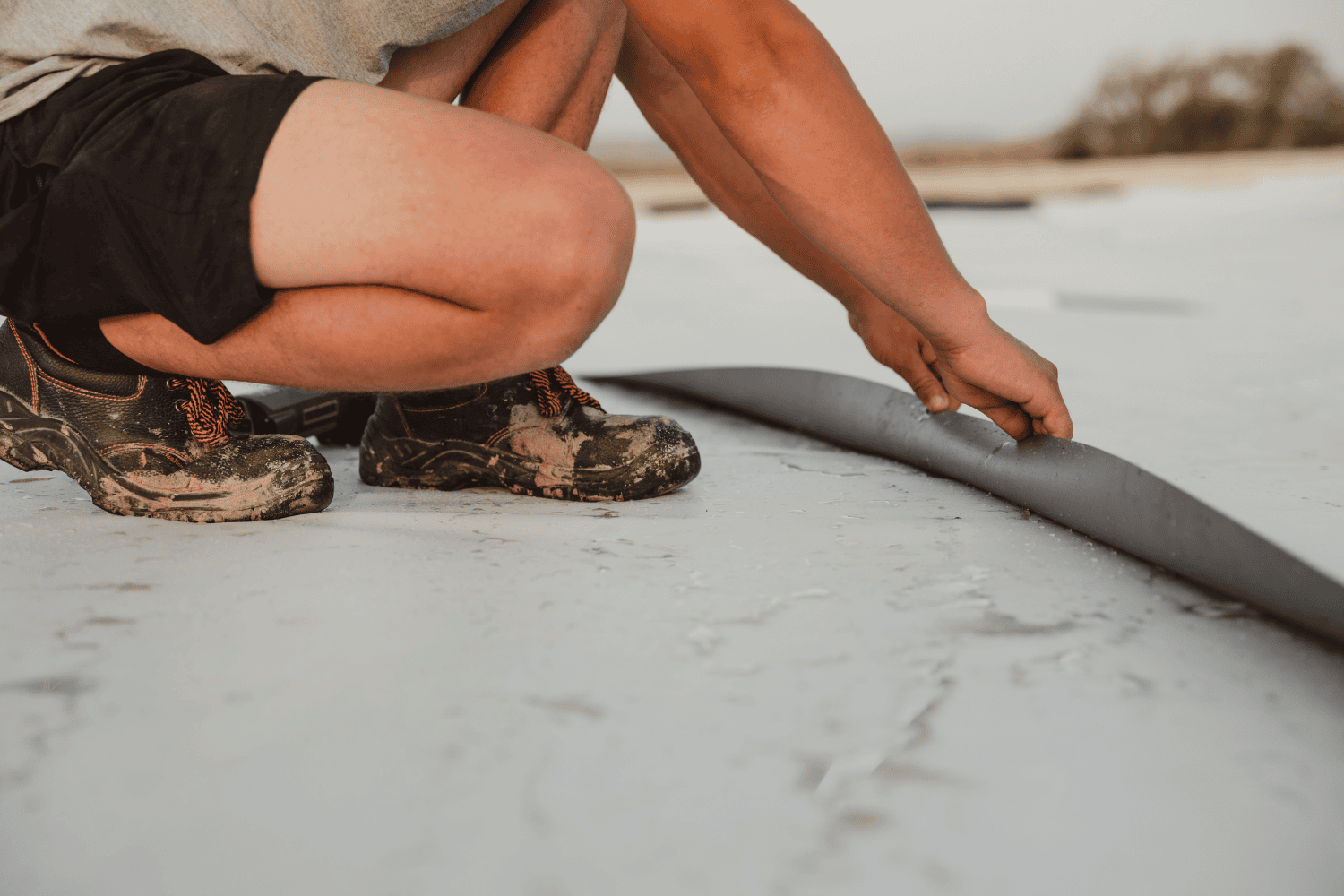Top Benefits of Using a Roof Membrane
Looking for a solution to protect your flat or low-pitched roof? A roof membrane might be what you need. These materials prevent water leaks and offer long-lasting durability. In this article, you’ll learn about the different types, benefits, and installation methods of roof membranes.
Key Takeaways
-
Roof membranes provide seamless, waterproof barriers ideal for flat and low-pitched roofs, protecting buildings from water intrusion.
-
Different types of roof membranes, including thermoset, thermoplastic, and modified bitumen, offer unique benefits in durability, installation methods, and energy efficiency.
-
Proper maintenance, including regular inspections and cleaning, significantly prolongs the lifespan and performance of roof membranes, reducing long-term costs.
What is a Roof Membrane?

Roof membranes are thin, continuous sheets of material designed to prevent water from leaking into buildings, a critical function for any roofing system. Predominantly used in flat roofing systems, roof membranes create a seamless, watertight covering that protects the structure beneath from water intrusion and subsequent damage.
These membranes are not limited to flat roofs; they are also highly effective on low-pitched roofs, offering flexibility and versatility in their applications. Common roofing material used for these membranes includes thermoplastic, synthetic rubber, modified bitumen, and liquid polyurethane, each chosen for their durability and waterproofing capabilities.
Incorporating weatherproofing components, reinforcement, and surfacing allows roof membranes to provide comprehensive protection against the elements.
Types of Roof Membranes

Knowing the types of roof membranes available helps in selecting the best roofing system for specific needs. The most common types include PVC, EPDM, and TPO, each offering unique benefits in terms of material properties and application methods.
Other variants, such as modified bitumen and thermoset membranes, also play significant roles in the commercial roofing market. These will be explored in more detail below.
Thermoset Membranes
Thermoset membranes are primarily made from synthetic rubber, with EPDM (ethylene propylene diene terpolymer) being the most widely used type. Known for their high fire resistance and durability, thermoset membranes create a single, continuous piece that enhances waterproofing and reduces the risk of leaks. EPDM membranes, in particular, can last for over 20 years, with options available in various thicknesses, typically between 45 and 60 mils.
These membranes can be installed using different methods, including fully adhered, mechanically fastened, or ballasted, depending on the specific requirements of the roof. Their high resistance to UV rays and temperature fluctuations makes them suitable for a range of climates, providing reliable protection and energy efficiency.
Thermoplastic Membranes
Thermoplastic membranes, including pvc roofing (polyvinyl chloride) and TPO (thermoplastic olefin), are highly valued in the commercial roofing market for their durability and leakproof properties. PVC roofs are particularly noted for their chemical resistance, making them suitable for environments with harsh conditions. Typical thicknesses for PVC membranes range from 45 to 90 mils, with 60 mils being common.
The installation of thermoplastic membranes can be achieved through various methods such as fully adhered, mechanically fastened, or ballasted. Heat welding is a preferred method as it creates strong, seamless bonds that enhance the waterproofing capabilities of the roof. These membranes are designed to reflect UV rays, contributing to energy efficiency by reducing cooling costs.
Modified Bitumen Membranes
Modified bitumen membranes are made from asphalt with added polymers to enhance elasticity and durability. These membranes are reinforced with layers that provide additional strength and resistance to harsh environmental conditions. The inclusion of additives like rubbers or plastics during manufacturing improves the performance of modified bitumen membranes.
Installation methods for modified bitumen membranes include torch application, cold adhesive, hot-mopping, and self-adhering materials, offering flexibility in application based on the specific needs of the modified bitumen roof. These membranes are often installed in multiple layers, which enhances their protective capabilities and extends their lifespan.
Advantages of Roof Membranes

Roof membranes offer distinct advantages over traditional roofing options. They require less maintenance, provide efficient waterproofing, and are easier to repair when necessary.
Modern synthetic roofing membranes have revolutionized the roofing industry by creating nearly leakproof roofs, ensuring long-term protection and peace of mind for building owners.
Waterproofing and Leak Prevention
Membrane roofing is designed to create a watertight barrier that protects the interior of buildings from water damage. Modern synthetic membranes are engineered to provide almost impermeable roofs, significantly reducing the risk of leaks. The use of methods like heat welding ensures that seams in thermoplastic membranes form strong, durable bonds that are less prone to leakage compared to traditional roofing materials.
Cleaning and debris removal are essential to maintaining the waterproofing effectiveness of roof membranes. Preventing debris accumulation, which can lead to water pooling and potential damage, helps ensure the roof membrane continues to perform optimally.
Durability and Longevity
The durability and longevity of roof membranes are influenced by factors such as membrane thickness, exposure to extreme weather, and proper maintenance. Modern membrane roofing systems are designed to withstand UV rays and temperature fluctuations, minimizing issues related to expansion and contraction. Timely inspections and debris removal are essential in extending the lifespan of roof membranes.
Effective maintenance practices prolong the life of the membrane and address wear and tear before they escalate into major issues. Installation techniques like mechanical fastening can significantly enhance the overall performance and durability of the roof membrane.
Energy Efficiency
Certain roof membranes, such as TPO, are designed with reflective properties that help lower energy costs by reflecting sunlight. These membranes can significantly reduce cooling expenses, making them a cost-efficient choice for buildings in warmer climates. PVC and TPO membranes, in particular, enhance energy efficiency by reflecting heat away from the structure, helping to maintain a cooler interior environment.
Maintaining the reflective properties of these membranes maximizes their energy efficiency benefits. Regular cleaning prevents debris and algae growth, which can diminish the membrane’s reflective capabilities.
Installation Methods for Roof Membranes

The installation method chosen for roof membranes can significantly impact their performance and longevity. Common methods include heat welding, cold adhesive application, and mechanical fastening, each offering unique benefits and suitable for different types of membranes and building requirements.
The following sections will explore these methods in more detail.
Heat Welding
Heat welding is a popular installation method for thermoplastic membranes, creating strong bonds between seams that enhance the roof’s overall durability and waterproofing capabilities. This method is effective even in low temperatures, where other adhesives may fail, ensuring reliable performance in various weather conditions.
Cold Adhesive Application
Cold adhesive application is ideal for modified bitumen membranes, providing a strong bond without the need for heat. This method offers several advantages, including ease of installation and reduced risk of damage to the membrane, making it a popular choice for many roofing projects.
Mechanical Fastening
Mechanical fastening is often used with single-ply membranes to provide enhanced stability against environmental factors. This method is particularly effective in high wind areas, preventing membrane uplift and ensuring the structural integrity of the roof.
Maintenance Tips for Roof Membranes
Proper maintenance is essential to ensure the longevity and performance of roof membranes. Regular inspections, cleaning, and prompt repairs are key practices that help in maintaining the integrity of the roofing system and preventing costly damages.
The following sections will delve into these maintenance tips in more detail.
Regular Inspections
Regular inspections, at least twice a year and after severe weather events, help identify potential issues early. Inspections can uncover minor problems like loose fasteners or punctures, allowing for timely repairs that prevent more significant damage and ensure the roof remains in optimal condition.
Cleaning and Debris Removal
Cleaning roof membranes with a soft brush or pressure washing removes debris without harming the membrane. Keeping the roof clear of debris prolongs its lifespan by preventing potential damage and ensuring the membrane’s waterproofing capabilities remain effective.
Prompt Repairs
Quickly addressing minor damages prevents them from escalating into larger, more costly problems. Prompt repairs reduce the risk of leaks and extensive damage, ensuring the membrane’s durability and long-term performance.
Choosing the Right Roof Membrane for Your Building

Choosing the right roof membrane requires assessing building requirements, considering environmental impact, and balancing budget constraints. Each factor is crucial in selecting a membrane that meets specific needs and ensures long-term performance and sustainability.
Assessing Building Requirements
Selecting the appropriate roof membrane requires a thorough understanding of the building’s specific needs, including structural considerations and local climate conditions. Membrane roofs are often chosen for commercial buildings but are also increasingly popular in residential projects due to their versatility and performance.
Evaluating these factors ensures the selected membrane will provide optimal protection and longevity.
Considering Environmental Impact
Environmental sustainability is a significant consideration when choosing roofing materials. Eco-friendly membrane options help reduce the environmental damage associated with traditional roofing materials. Choosing roofing membranes that can be recycled at the end of their lifespan contributes to sustainability and minimizes the impact on local ecosystems.
This approach benefits the environment and aligns with modern sustainable building practices.
Budget Considerations
Budget is a crucial factor in selecting the right roof membrane. While the initial costs of high-quality membranes might be higher, they can lead to significant long-term savings through reduced energy costs and fewer replacements. Balancing the upfront investment with projected long-term savings and maintenance expenses ensures a financially sound roofing decision.
Regular maintenance and prompt repairs also help mitigate unexpected costs, making membrane roofing a cost-efficient option.
Summary
In summary, roof membranes offer numerous benefits over traditional roofing materials, including superior waterproofing, durability, and energy efficiency. Understanding the different types of roof membranes—thermoset, thermoplastic, and modified bitumen—helps in selecting the best option for specific roofing needs. Each type has its unique advantages, making them suitable for various applications and climates.
Choosing the right installation method, maintaining the roof membrane properly, and considering both environmental and budgetary factors are essential steps to ensure the longevity and performance of the roofing system. By making informed decisions and investing in quality materials, building owners can enjoy the peace of mind that comes with a reliable, long-lasting roof. Remember, the right roof membrane not only protects your building but also contributes to its overall efficiency and sustainability.
Frequently Asked Questions
What are the main types of roof membranes?
The main types of roof membranes are thermoset membranes (such as EPDM), thermoplastic membranes (including PVC and TPO), and modified bitumen membranes. Each type offers unique benefits suited to various roofing applications.
How often should roof membranes be inspected?
It is essential to inspect roof membranes at least twice a year and after severe weather events to identify and address potential issues promptly. Regular inspections help maintain the integrity of the roof.
What is the benefit of using heat welding for membrane installation?
Using heat welding for membrane installation ensures strong, seamless bonds that improve waterproofing and durability, particularly for thermoplastic membranes. This method significantly enhances the longevity and effectiveness of roofing systems.
Can roof membranes improve energy efficiency?
Certainly, roof membranes such as TPO and PVC can enhance energy efficiency by their reflective properties, which help to mitigate cooling costs by deflecting sunlight and heat away from the building.
What factors should be considered when choosing a roof membrane?
When choosing a roof membrane, it is essential to consider the building’s specific needs, local climate conditions, environmental impact, and budget constraints. This comprehensive assessment will help you select the most suitable and cost-effective roofing solution.



